Originally planned for October 2020 to mark the 500th anniversary of Raphael’s death, this monumental exhibition was pushed back due to the pandemic (and probably because they didn’t want to just move it online like they did with Artemisia). I would say they made the right choice, as this exhibition boasts to be the first one outside of Italy to showcase the full scope of Raphael’s work: as an artist, architect, designer and more. They certainly spared no expense, if you just look at how many galleries and museums loaned their own Raphael collections for this; just to quote a few – Vatican Museums, Uffizi Galleries, the Louvre, and National Galleries in Spain, Germany and the USA.
Furthermore, I had a more personal reason for wishing to see this in person. When I was at University, I had the opportunity to study for an year in Italy, with Erasmus Abroad – specifically in Urbino, in the Marche region, which is where Raphael was born. I also took a course on the history of marchigian art while there, so I was very excited when this exhibition was announced. So let’s jump right in.
A short history
Raphael (in Italian, Raffaello Sanzio da Urbino) was born on 28 March 1483 in Urbino, a small town in the Marche region in central Italy. The house he was born in still exists today, at number 57 on Via Raffaello in Urbino (obviously they renamed the street after him). The house/museum, Casa Natale di Raffaelo, is available to visit – there’s a virtual tour in both Italian and English available on their website.
Raphael’s father was Giovanni Santi, the court painter of the famous Ducal court of Urbino. Unfortuately, Raphael would lose both his parents early in life. He was raised by an uncle, and started his artistic training in Urbino. His first commission was at the tender age of 17. He started expanding, doing work in the neighbouring Perugia and Florence. Once in Rome, he starts work for Pope Julius II by decorating the papal apartments in the Vatican Palace. He continues working for the next pope, Pope Leo X, when appointed the chief architect of the St. Peter Basilica.
I cannot overestimate just how many projects Raphael juggled at his most productive – painting, architect, excavation work, sketching, metalwork. He died quite suddenly, after a short illness, in 1520; he was only 37. And yet his influence on history was indisputable.
The exhibition
Due to circumstances outside of my control, I find myself waltzing to the National Gallery to see the Raphael exhibition on the very last weekend it's open.
I pick up the exhibition booklet, containing the room plan and descriptions of all the works on display. I love it when exhibitions have these booklets – it’s such a nice change from having to crowd around a painting to read the tiny print description on the wall. This way, I can hang around at some distance from the painting, take it in its wide view, and read the details at my own leisure.
The exhibition spreads across seven rooms, themed: early works, Madonnas, his Florence period etc. There are very few multimedia pieces added in, so it’s mostly looking at hanged pictures. It’s fine – it’s hard to go wrong with the classic structure for an exhibition, especially if it’s a Renaissance artist. Overall, I am quite satisfied, but still feel like the £27 ticket price was extortionate (and yet so typical of the National Gallery).
In any case, here are a couple of my favourite works from the exhibition.
Selected works
These works portrays martyrs Saint Sebastian and Saint Catherine with somber expressions, but very vivid colours. Saint Sebastian is a curious choice, because it goes against the usual tradition of portraying him almost naked, tied to a tree and pierced with arrows. Saint Catherine, who was tortured on the wheel, has a corkscrew tension in her body that alludes to that.

Saint Sebastian
~1502-3
Painted for private devotion
Tempera and oil on wood
Housed in Accademia Carrara, Bergamo, Italy
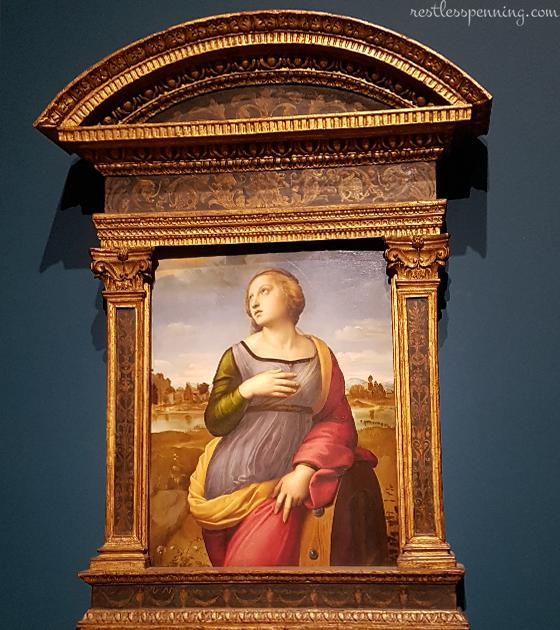
Saint Catherine of Alexandria
~1507
Oil on poplar
Reframed in original 16th century Italian tabernacle frame
Housed in the National Gallery, London, UK
The tondo is a round painting, mainly associated with Florentine painting. Here are two Raphael tondos with the Madonna theme. I chose to present them in pairs to show how his earlier attempt was not entirely successful (note how the two children are cut off by the bottom of the painting). Contrast it with the later attempt, which uses the form and medium much more effectively.

The Terranuova Madonna
~1505-6
The Virgin Mary and Christ with the infant Saint John the Baptist and and unknown second child
Oil on poplar
Housed in the Gemäldegalerie, Berlin, Germany
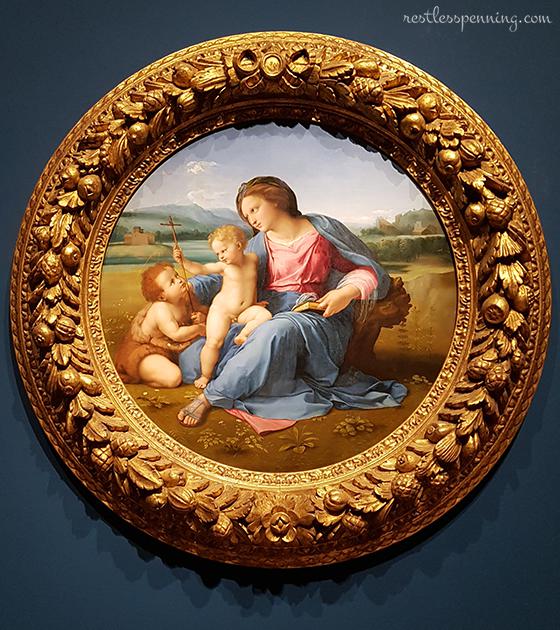
The Alba Madonna
~1509-11
The Virgin May and Christ with the infant Saint John the Baptist
Oil on wood transferred to canvas
Housed in the National Gallery of Art, Washington DC, USA
This is one of the more famous artist portraits out there. Painted when Raphael was around 23 years old. The artist looks directly at the viewer, engaging them head-on.

Self portrait
~1506
Oil on wood
Housed in Gallerie degli Uffizi, Florence, Italy
.jpg)
Self portrait (detail)
These next ones are very interesting seen next to each other, as it shows the typical portraiture of women at the time. The first one is reminiscent of Leonardo da Vinci’s Mona Lisa, which was studied by many Floretine artists at the time. The middle one has a very dignified air to it. The third one is thought to be a preparatory sketch for a portrait that was either lost or never painted.
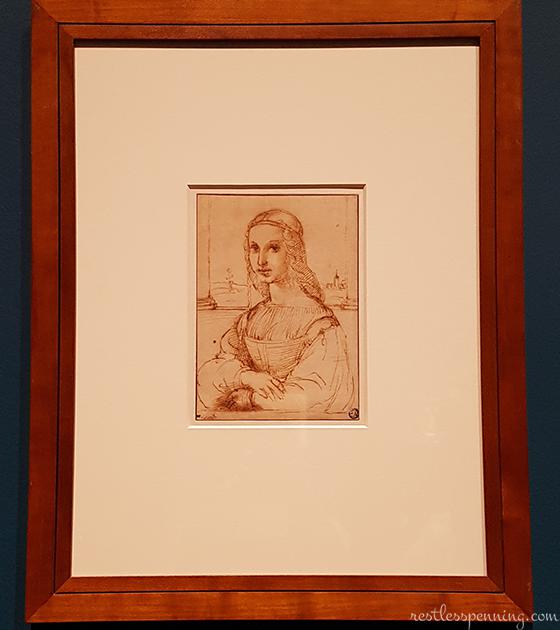
Study for a portrait of a young woman
~1505-6
Pen and brown ink over traces of black chalk
Housed in Musée du Louvre, Paris, France
.jpg)
Portrait of a woman (La Muta)
~1505
Oil on lime wood
Housed in Galleria Nazionale delle Marche, Urbino, Italy
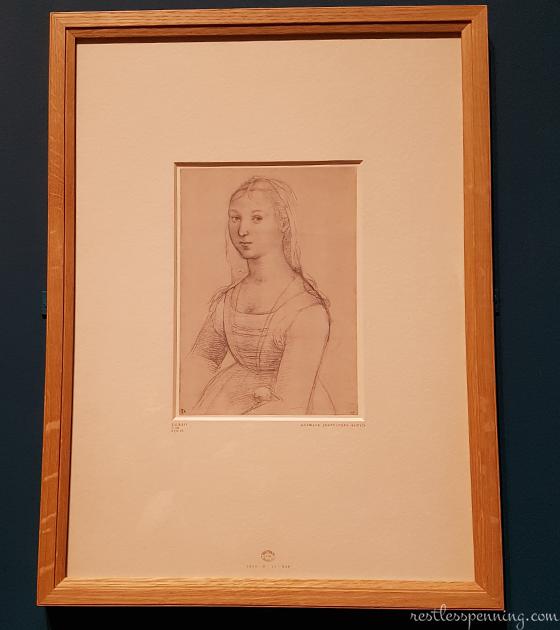
A young woman, half-length, seated
~1505-6
Black chalk
Housed in the British Museum, London, UK
The following sketches by Raphael were used to create bronze works in reliefs. These two sketches are for The Incredulity of Saint Thomas, where Saint Thomas seeked confirmation of the resurrection by placing his hand into the wound of Christ. I particularly like the second sketch, because more than just a paper sketch, it uses a metalpoint (a metal, sometimes silver, stylus that leaves fine lines on prepared paper) to see how it would look like on a relief sculpture. The Incredulity of Saint Thomas was designed as a pair with The Descent into Limbo, where after his death, Christ descends into hell to release the virtuous souls from the Old Testatment caught in limbo. Both bronze works were meant for the Santa Maria della Pace Church in Rome, but today they are housed in the Chiesa Abbaziale di Santa Maria in Milan (where Leonardo da Vinci’s Last Supper is also housed).
(pen and brown ink).jpg)
The incredulity of Saint Thomas (preparatory sketch)
~1511-12
Pen and brown ink
Housed in the Fitzwilliam Museum, University of Cambridge, UK
(silverpoint on pink prepared paper).jpg)
The incredulity of Saint Thomas (preparatory sketch)
Silverpoint on pink prepared paper, retraced with a stylus by another hand, contours and interior details retraced with the point of the brush and light grey ink
Housed in the Städel Museum, Frankfurt, Germany
Unfortunately, whilst the metal (ha!) pair The Incredulity of Saint Thomas/The Descent into Limbo were indeed on display at this exhibition, no photography was allowed and I had difficulty finding good photography online. It’s very likely they don’t allow photography inside the church the works are usually housed in, either. I did manage to find a National Gallery document for this Raphael exhibition called Immunity from Seizure, which lists these works as property of the Italian state itself (as opposed to just a museum - which is quite intriguing) and – of course – the photos in the pdf cannot be reproduced without permission either.
But lo and behold, my Internet sleuthing led me to the blog Renaissance Bronze, where writer Michael Riddick discusses Raphael’s metal works in his post Metalwork in the ambit of Raphael. Full credit to Michael for the photos below – and give their post a read too, as it’s absolutely fascinating.
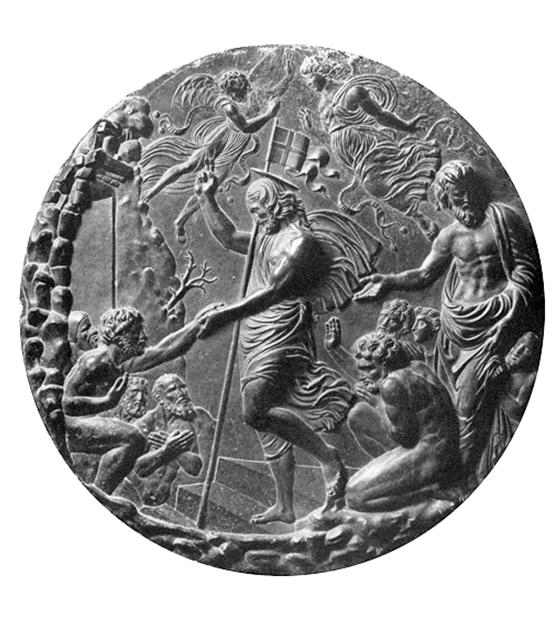
The incredulity of Saint Thomas (preparatory sketch)
~1511-22
Bronze tondo
Housed in Chiaravalle Abbey, Milan, Italy
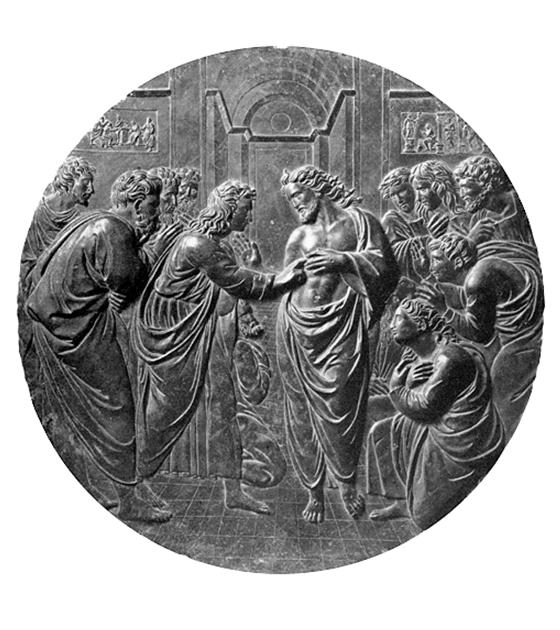
The descent into limbo
~1511-22
Bronze tondo
Housed in Chiaravalle Abbey, Milan, Italy
Another very well-known Raphael piece is the School of Athens fresco, painted on a wall in the Stanza della Segnatura at the Vatican Palace. For this exhibition, it has been reproduced close to full-scale and at eye-level. At its centre, Plato and Aristotle personify the two major fields of Western philosophy.
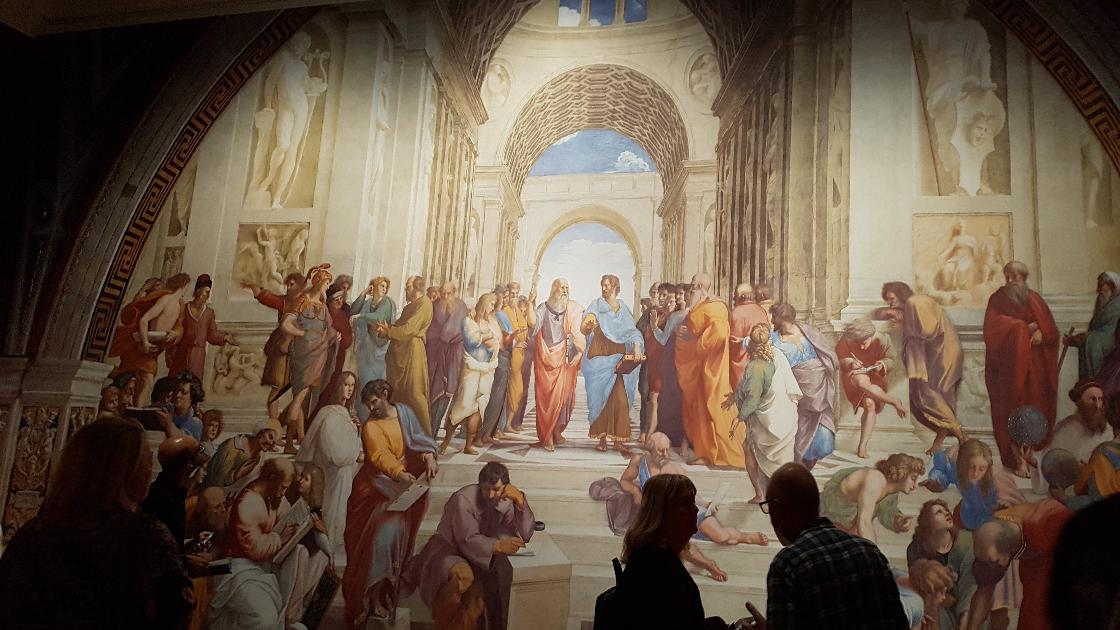
School of Athens [reproduction] (original: fresco; 1509-1511)
This next one is quite interesting.

The Judgement of Paris
~1515-16
Engraving by Marcantonion Raimondi after a design by Raphael
Housed in the Whitworth, University of Manchester, UK
.jpg)
The Judgement of Paris (detail)
Arguably the illustration of a dramatic scene from Greek mythology, one can't help but notice the cheeky androgynous person in the bottom-right corner, breaking the fourth wall by gazing directly at the viewer. A few hundred years later, in 1863, Edouard Manet would recreate almost the exact same pose of those three characters in his Dejuner sur l’herbe.
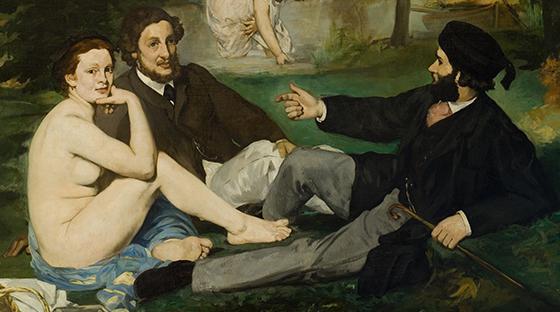
Manet - Dejuner sur l'herbe (1863)
Housed in Musée d’Orsay, Paris, France
There are two striking altar pieces, painted over a decade distance from each other, that really show the artist’s evolution in terms of brushwork and facial expressions.
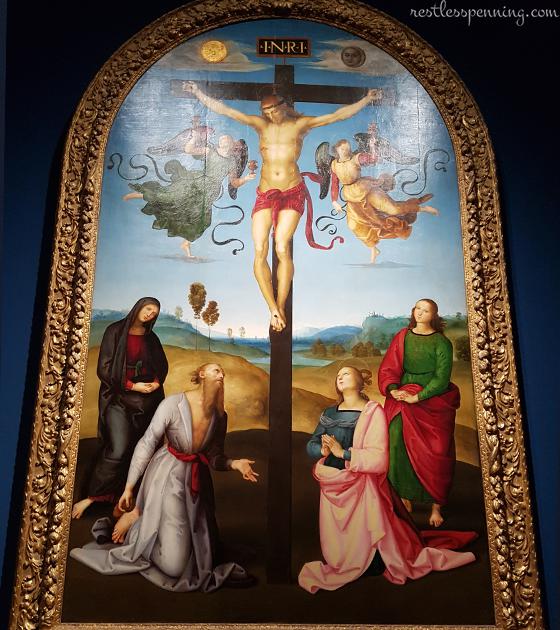
The Mond Crucifixion
~1502-3
Altarpiece for the San Domenico church in Città di Castello
Kneeling figures at St. Jerome and and Mary Magdalene, flanked by the Virgin Mary and St. John
Oil on poplar
Housed in the National Gallery, London, UK
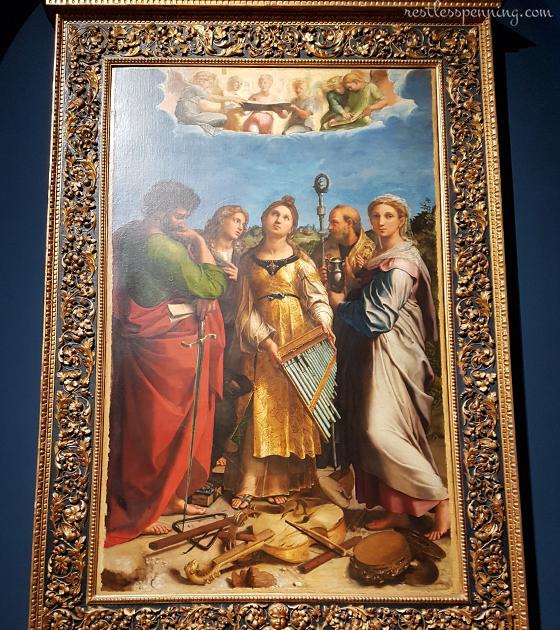
The Ecstasy of St. Cecilia
~1515-16
Altarpiece of a church in Bologna
Saint Cecilia with Saints Paul, John the Evangelist, Augustine and Mary Magdalene
Oil on wood, transferred to canvas
Housed in Pinacoteca Nazionale, Bologna, Italy
And to conclude, my absolute favourite Raphael work – a simple, intimate portrait - Fornarina meaning, a woman who works at an oven.
.jpg)
Portrait of a Woman (La Fornarina)
~1519-20
Oil on wood
Housed in Gallerie Nazionali di Arte Antica, Rome, Italy
 (close-up).jpg)
Portrait of a Woman (La Fornarina) (detail)
Article originally posted on now-defunct old blog, restlesspenning.com on 22 August 2022. Re-posted here on 9 August 2024.